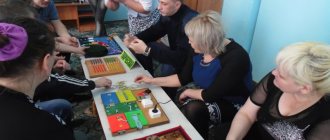Theatrical didactic game in kindergarten
Didactic game “Glove theater or tell a story with your hands”
Purpose of the game: to develop the creative abilities of preschoolers through theatrical activities. Tasks for the teacher: - teach children to independently combine hand movements with text; — enrich children’s vocabulary when telling a fairy tale as a presenter; - develop children's attention, memory, imagination, fine motor skills of the fingers; — to stimulate children’s interest in theatrical play, to participate in it together with the teacher and with peers. Game task for a child: motivation of the child’s activity in the game (tell or make up a fairy tale in an unusual way - with your hands together with the teacher and with peers). Number of players: 5-7 people. Place of play: in a group room or outdoors. Presenter: adult or child. Game actions. The adult offers to tell a fairy tale with their hands (using gloves) together with the children, and then independently come up with stories and tell them to their peers using the glove theater. Game attributes: screen, fabric with slots, glove characters. Rules of the game: Stage I: Teacher: Guys, let's remember what types of theaters we use with you during performances in kindergarten? Children: shadow, puppet, finger, table. Teacher: That's right, guys. Teacher: today I will introduce gloves. Teacher: This is an unusual theater. There are gloves in front of you, but they are not simple, but fabulous. Each glove has its own character. I suggest you choose any character, put on gloves, and stand behind a screen so that you cannot be seen. Guys, we will tell a fairy tale only with our hands. I will be the host, tell the story, and you will perform the movements, putting your hand through the slits of the fabric. Be careful. Stage II: Teacher: Guys, we told a fairy tale with our hands. Who remembers what it's called? Children: How the fish found friends. Teacher: What heroes did you meet in this fairy tale? Children: turtle, crab, octopus, jellyfish. The teacher suggests remembering the hand movements of each character. Teacher: And I suggest you come up with a short fairy tale and story yourself and role-play it. The teacher helps children with guiding questions to choose the name of the fairy tale, characters, come up with movements for them, etc. For example: - about whom or what do you want to come up with a fairy tale? - What are the main characters in this fairy tale? — what is the character’s character? - how can you show with your hands that he is cheerful, slow, angry... Contents of the game: Teacher: Guys, have you been to the theater? Children: Yes Teacher: Who did you go to the theater with? Children: With parents, grandmother, friends... Teacher: Guys, what types of theaters in our city do you know? Children: Puppet theater, theater for young spectators, musical Teacher: That's right, and we also have a Cossack theater in the city, a youth theater, a one-man theater. Teacher: What is in the theater? Children: Stage, auditorium, wardrobe, buffet, box office... The teacher complements the children’s answers (foyer, bell, curtain, backstage, decorations) Teacher: Who works in the theater? Children: Actors, cashier, director. The teacher complements the children's answers (make-up artist, costume designer, tailor, artistic director, administrator) Teacher: Let's remember what types of theaters we use during performances in kindergarten? Children: shadow, puppet, finger, tabletop Teacher: That's right, guys Teacher: Guys, do you want to play glove theater? Children: Yes Teacher: This is an unusual theater. There are gloves in front of you, but they are not simple, but fabulous. Each glove has its own character. I suggest you choose any character, put on gloves, and stand behind a screen so that you cannot be seen. Guys, we will tell a fairy tale only with our hands. I will be the host, tell the story, and you will perform the movements, putting your hand through the slits of the fabric. Be careful. While telling the story, the teacher explains to the children how to perform the movements of each character. In the future, children will be able to independently invent movements in accordance with the text. Teacher: Fairy tale “How the Fish Found Friends.” There lived a small fish in the blue sea. Her name was Zolotinka (a fish appears and performs smooth movements “as if swimming” in different directions). She was so small that the sea inhabitants did not notice her at all. Sometimes you will meet an important turtle (a turtle appears - the child slowly moves his hand to one side or the other), a fast crab (a crab appears, the child quickly moves all his fingers), a cheerful octopus (an octopus appears - the child moves all his fingers, making movements hand forward, backward) to play and dance, but Zolotinka is not invited to come along (the children show with their hands “as if they are having fun” - they wave their hands in one direction or the other, you can take each other’s fingers, perform movements forward, backward) , they said she was small. The fish was very worried that it had no friends, which is why it was always sad (the child removes his hand from the screen). And then one day, an evil Medusa sailed into the blue sea (Medusa appears with a net - the child turns her hand in different directions) saw how the sea inhabitants were having fun and decided to bewitch them (the turtle, crab, octopus disappear - the children remove their hands from behind the screen) they have a magic net on them (the child swings his hand strongly in different directions, fastens it to a large shell, and hides the key under a stone in a narrow cave (Medusa disappears - the child removes his hand from the screen). Zolotinka found out about this and decided to help the sea inhabitants (a fish appears - the child shows smooth movements with his hand “as if he were swimming quickly) She swam up to a narrow cave and easily made her way inside (the fish disappears and appears on the other side with a key) She found the key, opened the lock and slowly began to free the sea inhabitants from the net (the child pulls net) It was very difficult for her to do this, since she was small and sometimes did not have enough strength, but despite all the difficulties the fish managed. When Zolotinka completely removed the net, the sea inhabitants were very happy (a turtle, a crab, an octopus appeared) They thanked Zolotinka, and they felt so ashamed that they had not noticed her before. The fish was not at all offended by them, but on the contrary, was glad that it had found friends (the children take each other’s fingers and swing in different directions, and then remove their hands from behind the screen). Teacher: Guys, this is how we all told the story together with our hands. Well done.
Result. In the process of conducting this didactic game, children learned not only to independently perform hand movements in accordance with the text, but also to independently invent and act out small fairy tales, stories, and scenes with their peers. In the process of play activities, preschoolers developed a respectful attitude towards each other. They learned to overcome communication difficulties and self-doubt.
We recommend watching:
Theater in the 2nd junior group Do-it-yourself table theater based on Russian folk tales Theatrical game in the junior group of the kindergarten “The Journey of Little Red Riding Hood” with presentation Theatrical game for preschoolers. Abstract
Similar articles:
Theatrical games in the middle group. Card file according to Federal State Educational Standards
Dear adults!The game is intended for the emotional and intellectual development of children aged 5-9 years. Children become familiar not only with the names and characteristic external features of the 8 basic (innate) emotions, but also learn to distinguish and compare emotional sensations, both their own and those of others. Mood is a stable experience of emotions. By playing with emotions, kids will learn to control their own mood, which will positively affect their relationships with the outside world. In our theater there are 8 main roles: Interest, Joy, Surprise, Sadness, Anger, Disgust, Fear, Guilt, presented in the form of masks. In addition, 4 characters participate, by whose appearance children must determine their role and emotion. The game develops voluntary attention and thinking and is suitable for those who can read and those who are learning to read.
GAME COMPLETENESS:
1. 8 mask cards;
2. 4 cut cards with characters (32 pieces);
3. Envelope for cards;
4. Rules.
Cut the paired mask cards in half into separate cards, and the character cards into small cards (32 pieces).
RULES OF THE GAME
OPTION 1.
Invite the children to carefully examine the mask cards and draw their attention to the variety of external signs of the manifestation of emotions, their differences and similarities. Talk about when a particular emotion arises. Distribute the mask cards equally among the players. Let everyone try to depict this emotion on their face. The presenter shows small cards one at a time, choosing at random. Children must collect 4 cards for their mask with characters experiencing the same mood: cards with joyful characters are collected for the mask of joy, cards with sad characters for the mask of sadness, etc. The one who collects his heroes faster than others wins.
OPTION 2. "One actor theater"
This game only involves single cards. The players' task is to collect all the pictures related to one character. The presenter distributes one card with a hero. After this, the players take turns passing the rest, one card at a time, to their neighbor on the left, in a circle, one at each turn. The player keeps cards that are suitable in content. The first one to collect his character's emotions wins.
OPTION 3. "Master Class".
Put on an impromptu performance!
The game involves all cards and cards that are folded together, face down. Players take turns choosing a card or card and, without revealing its contents to other players, depict this emotion and character. The rest of the participants guess the mood by facial expressions and pantomimes.
The one whose performances were more successful and understandable wins.
4 OPTION. "Golden Mask".
Only mask cards are used in the game. They can be cut along the lines into 4 parts. These parts are turned over and mixed. Children, choosing one at a time, must reassemble the mask. The one who collects the mask the fastest wins.
Didactic games for the development of children's theatrical abilities. - presentation
Didactic games for developing children's theatrical abilities
Contents Didactic game “Guess the fairy-tale hero” Didactic game “Visiting a fairy tale” Didactic game “Guess the bell” Didactic game “Flower Music”
Didactic game “Guess the fairy-tale hero” Purpose: To consolidate children’s knowledge about the heroes of their favorite fairy tales. Develop speech, intonation expressiveness, imagination, and the ability to analyze the actions of fairy-tale characters. Progress of the game: The teacher invites the children to listen to a short quatrain about a fairy-tale hero. Children must guess the hero from the fairy tale and, with the help of facial expressions and gestures, convey the characteristics of his character.
Round, tasty and ruddy, He did not listen to mom and dad. Straight from the stove, jump and gallop, rolled away... KOLOBOK
The bun rolled off the porch and set off along the path into the forest. Following him, with a click of his teeth, a hungry man jumped out... WOLF
Everyone in the forest is afraid of the wolf, he loves to bite. Walks in soft slippers He is behind the red... Little Red Riding Hood
Grandfather Mazai is floating along the river. And along the shore on the stove He just rides without a goal Good fellow... Emelya
The whale shoots up fountains, And an eagle flies above it - The Good Doctor is in a hurry to Africa... Aibolit
The Firebird has a long tail. He has a secret, he is not simple. Only one knows what is in the tail and how... Ivan is a fool
The robber has a girlfriend, whiles away her life in a hut. The one on chicken legs and is called... Grandma Yozhka
All bears love honey. Use your paw to remove it from the honeycomb. That this rumor is true. Winnie the Pooh will prove it to you
Winnie the Pooh sings sawdust, There is sawdust in his head, There is a badge on his chest. And on it is a friend... Piglet
Didactic game “Visiting a fairy tale” Purpose: To consolidate children’s knowledge about their favorite fairy tales. Develop speech, memory, thinking, imagination, the ability to analyze the actions of fairy-tale characters. Progress of the game: An adult invites the children to split into two teams (a team of boys and a team of girls) and reads them an excerpt from a fairy tale they know. Children guess the fairy tale. Whose team was first gets a chip. The team with the most chips wins.
“Kolobok” He left his grandmother, And he left his grandfather, And he left the hare, the wolf, the bear, A round, mischievous boy.
“Doctor Aibolit” He treats mice and rats, Crocodiles, hares, foxes, Bandages the wounds of an African monkey. Never rests. He saves everyone day and night.
“Pinocchio” The wooden mischief-maker came from a fairy tale into our lives, A favorite of adults and children, A daredevil and an inventor of ideas. On land and under water, Looking for a golden key
“Cinderella” I wish the evening would quickly approach, And the long-awaited hour would come, So that I could go to a fairy-tale ball in a gilded carriage! No one in the palace will know where I come from or what my name is, But as soon as midnight comes I will return to my attic.
“Little Red Riding Hood” Grandmother loved the girl very much and gave her a red riding hood. The girl forgot her name. Well, tell me her name!
“The Three Little Pigs” The nose is round, with a snout, It’s convenient for them to dig in the ground, The tail is small with a hook, Instead of shoes - hooves. Three of them - and how alike the friendly brothers are. Guess without a hint, who are the heroes of this fairy tale?
“Three Bears” Near the forest, on the edge, Three of them live in a hut. There are three chairs and three mugs, three beds, three pillows. Guess without a hint, who are the heroes of this fairy tale?





